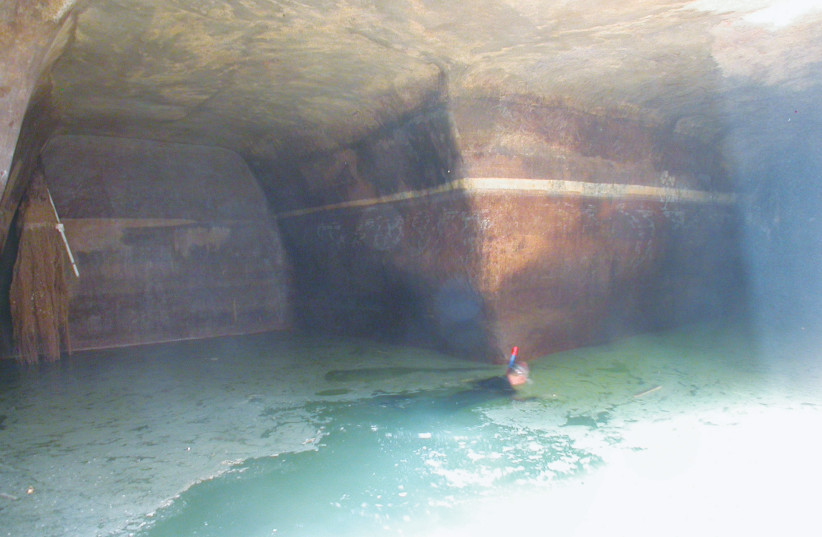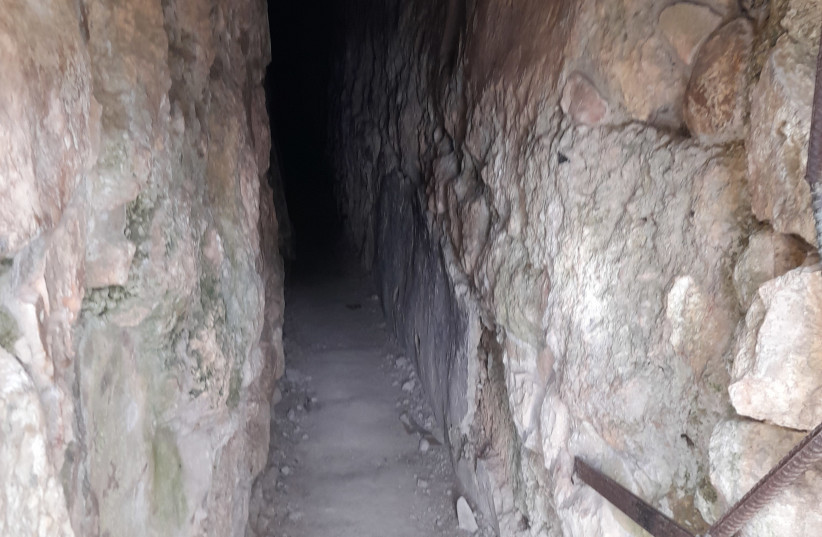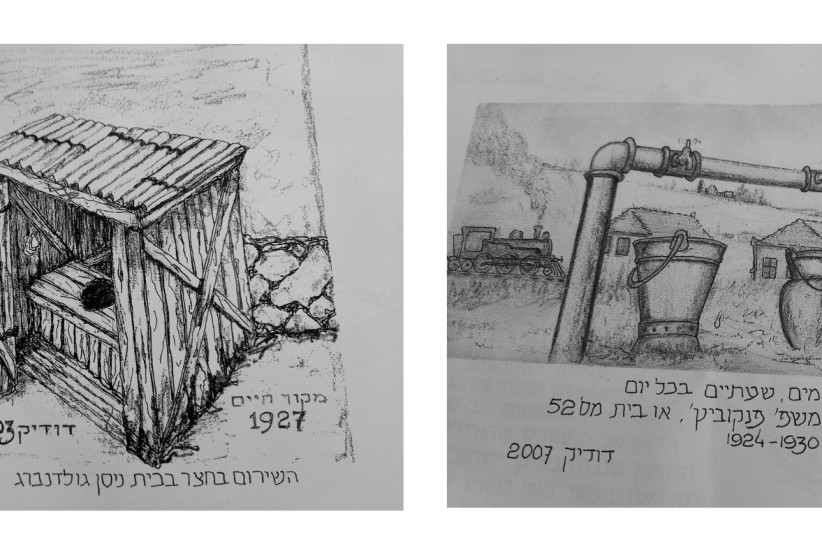Even in First Temple times approximately 3,000 years ago, water cisterns were painstakingly chiseled into the rock, then coated with sealing layers of yellow waterproofing plaster to form substantial underground reservoirs. When a cistern of this type was discovered near the Temple Mount in 2012, it proved that the Gihon Spring, though useful, was not an adequate source of water for Temple needs.
On August 8, 2019, after Nadav Shragai of the Jerusalem Center for Public Affairs visited this First Temple reservoir, he reported on its dimensions: 4.5 meters high, 5.5 meters wide and 12 meters long, with an estimated capacity of 250 cubic meters. His article also noted the 19th century mapping of 49 cisterns and 42 aqueducts on the Temple Mount by the famous British engineer Sir Captain (later General) Charles Warren of the PEF (Palestine Exploration Fund), founded in 1865 by Queen Victoria.
Warren was the first researcher to excavate today’s City of David hill, south of the Temple Mount, in 1867. He entered the tunnel through the Gihon Spring. Warren’s shaft is a related discovery that the engineer already described in 1865. Many of us have waded through the waters of the nearby man-made Siloam Tunnel, also called Hezekiah’s Tunnel. Shragai also mentions mapping similar to Warren’s by Italian engineer Ermete Pierotti, an employee of the Ottoman governor in the late 1850s, that was published posthumously in 1888.
Over 2,000 years ago the Hasmonean kings also actively constructed aqueducts in Jerusalem. The writer visited a section of the water tunnel in Armon Hanatziv a few months ago on a walking tour that followed the aqueduct’s underground route in that area, marked by patterns of blue tile and grids. After meeting our guide from the Eshkolot organization, we began our walk on the sidewalk adjacent to the promenade. This tunnel section, part of the Lower Aqueduct to Jerusalem, though usually locked, is made accessible to the public at certain times and holidays. It was a 20-minute single file, one-way walk through a low narrow dark tunnel carved out of the rock – best undertaken by slim people equipped with cellphones or flashlights for illumination, and definitely not recommended for those susceptible to claustrophobia. After exiting, there is a short climb back toward the promenade.
The aqueduct was discovered in April 2015 when the Gihon water company prepared to lay new sewer pipes in two adjoining neighborhoods of East Jerusalem — Umm Tuba and Sur Baher. Surprised to discover a section of Jerusalem’s lower aqueduct, they called in the Israel Antiquities Authority (IAA) to excavate the area.
“The aqueduct operated intermittently until about 100 years ago,” said Ya’akov Billig, director of the excavation. He explained that since this ancient aqueduct was one of Jerusalem’s most important water sources, it was carefully preserved until an electrically operated water system replaced it approximately a century ago. Now that its importance is mainly historical, the Antiquities Authority is proceeding to preserve parts of the aqueduct, study them and render them accessible.
ON MAY 21, 2015, Times of Israel quoted Billig’s description of the lower aqueduct, which begins at the Ein Eitam spring near Solomon’s Pools south of Bethlehem and stretches 21 kilometers downhill to Jerusalem. “Despite its length, it flows along a very gentle downward slope whereby the water level falls just one meter per kilometer of distance. At first, the water was conveyed inside an open channel [covered with stone slabs], and about 500 years ago, during the Ottoman period, a terra cotta pipe was installed inside the channel in order to better protect the water.”
Billig added that while the aqueduct’s route traversed uninhabited areas when first constructed, due to Jerusalem’s expansion it now crosses several populated areas, including Umm Tuba, East Talpiot and Abu Tor. Though the Umm Tuba sections were concealed after the Antiquities Authority’s study, other accessible sections include the water tunnel of Armon Hanatziv near the promenade.
The future Montefiore Museum, planned by the Jerusalem Foundation for the vicinity of the Sultan’s Pool, will incorporate other visible sections of the low-level aqueduct – specifically that on the western side of Ben Hinnom Valley above the Derekh Hebron bridge. Incidentally, the now-dry pool named for Sultan Suleiman I (1520-1566) was one of Jerusalem’s most important water reservoirs for hundreds of years. According to excavation director Dr. Ron Beeri, on behalf of the IAA, “We are dealing with a very impressive aqueduct that reached a height of three meters.” Beeri explains that after repairing the aqueduct, Suleiman diverted its water “to the Sultan’s Pool and the impressive sabil (a Muslim public fountain for drinking water), which he built for the pilgrims who crossed the Derekh Hebron bridge and is still preserved there today.”
The second main watercourse to reach Jerusalem from the Hebron hills, also beginning at Solomon’s Pools, is the High-Level aqueduct. This aqueduct, dating back about 1,800 years to the second to third century CE, is approximately 13 km. long. It brought water to the upper city of Jerusalem for the benefit of King Herod’s palace and of Hezekiah’s Pool – the main source of water for visitors to Jerusalem. Some new sections of it, some 1.5 meters high and built of large stones, were discovered in 2009/2010 near Jaffa Gate in the Old City. The archeologists were helped in their excavation by some late 19th century studies of German Protestant scholar Dr. Conrad Schick.
Dr. Ofer Sion, excavation director on behalf of the IAA, explains how he glimpsed the edge of the aqueduct.
“When we removed the stones in its side and peeked into it, we saw a splendidly built aqueduct covered with stone slabs where one can walk crouched down for a distance of approximately 40 meters. It is very exciting to think that no one had set foot there for many hundreds of years. For now, we can date the section of the aqueduct that was exposed to the second century CE, to the time of the pagan city Aelia Capitolina, which was built on the ruins of Jerusalem following the Bar Kokhba Revolt in 135 CE. Presumably, however, the aqueduct was first constructed in the days of Herod, as we know from other places along its route, particularly in the Bethlehem area.”
Perhaps a new archeological park will grace this area in the future.
Another interesting though less significant aqueduct dating back 1,500 years was discovered in 2005 in a public playground called Detroit Garden at the junction of Hizkiyahu HaMelech and Rachel Imeinu streets in Katamon. After the children’s sandpit there kept caving in, excavations revealed a deep reservoir that was quarried along a natural rift in the bedrock during the Byzantine era and then plastered. Only an explanatory sign and elongated rows of blue and white tiles indicate the existence of this hidden aqueduct that is now paved over, but archive photos reveal an impressive site.
THE 20TH century saw some interesting related developments in Jerusalem. After the British took over control of Palestine from the Turks in December 1917, they modernized Jerusalem’s water system by laying three major pipelines. Jerusalem’s courtyard cisterns, which numbered in their thousands, would perhaps now be superseded. The new settlement of Makor Hayim, however, did not have an abundance of water in the 1920s, and its residents lined up daily for their allowance with buckets and pails.
When the British decided to end their mandate and withdraw from Jerusalem and Palestine in 1948, war was clearly on the horizon. Moreover, Jerusalem’s water supply would likely come under siege as all three pipelines traversed Arab areas. Dr. Tzvi Leibovitch, who managed the municipal water department under the British, realized the impending danger and took covert but effective steps to thwart it.
After a secret survey revealed more than 1,000 old cisterns in the Jewish neighborhoods, with a capacity of 22 million gallons, Leibovitch had a team clean up the cisterns, then fill them with water drawn off the regular supply. All of them were filled and sealed by February 1948.
Two months later, on May 8, 1948, the first pipeline was cut. On May 15, when five Arab armies invaded Israeli territory, the remaining pipelines were destroyed. The Arab legion (Jordanians) blew up the water pipelines/pumping station at Latrun. Jerusalem’s 100,000 Jewish civilians were under siege.
Every day during the siege, the water distribution brigade of Mishmar HaAm (note that a Katamon street bears the name: Mehalkei Hamayim), using either horse-drawn carts or trucks, would distribute water to residents. The latter had to cope with a tenth of their regular water allowance. The authorities and the Voice of Israel repeatedly explained how to economize by recycling the same water for cooking, laundry, cleaning floors and, finally, flushing the toilets. Basic foods were also strictly rationed.
Though the June 11, 1948 armistice ended the siege on Jerusalem, the shortages were traumatic for its inhabitants and left lasting scars. The writer witnessed how almost 20 years later, on the brink of the Six Day War, grocery shelves throughout the city were totally emptied of their contents.



